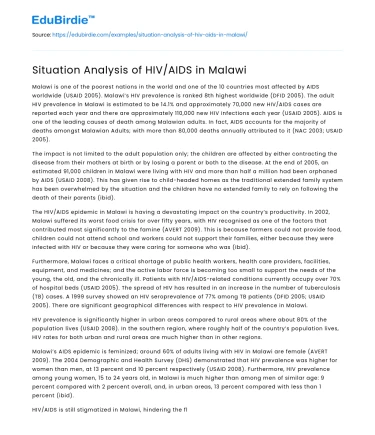Malawi is one of the poorest nations in the world and one of the 10 countries most affected by AIDS worldwide (USAID 2005). Malawi’s HIV prevalence is ranked 8th highest worldwide (DFID 2005). The adult HIV prevalence in Malawi is estimated to be 14.1% and approximately 70,000 new HIV/AIDS cases are reported each year and there are approximately 110,000 new HIV infections each year (USAID 2005). AIDS is one of the leading causes of death among Malawian adults. In fact, AIDS accounts for the majority of deaths amongst Malawian Adults; with more than 80,000 deaths annually attributed to it (NAC 2003; USAID 2005).
The impact is not limited to the adult population only; the children are affected by either contracting the disease from their mothers at birth or by losing a parent or both to the disease. At the end of 2005, an estimated 91,000 children in Malawi were living with HIV and more than half a million had been orphaned by AIDS (USAID 2008). This has given rise to child-headed homes as the traditional extended family system has been overwhelmed by the situation and the children have no extended family to rely on following the death of their parents (ibid).
Save your time!
We can take care of your essay
- Proper editing and formatting
- Free revision, title page, and bibliography
- Flexible prices and money-back guarantee
The HIV/AIDS epidemic in Malawi is having a devastating impact on the country’s productivity. In 2002, Malawi suffered its worst food crisis for over fifty years, with HIV recognised as one of the factors that contributed most significantly to the famine (AVERT 2009). This is because farmers could not provide food, children could not attend school and workers could not support their families, either because they were infected with HIV or because they were caring for someone who was (ibid).
Furthermore, Malawi faces a critical shortage of public health workers, health care providers, facilities, equipment, and medicines; and the active labor force is becoming too small to support the needs of the young, the old, and the chronically ill. Patients with HIV/AIDS-related conditions currently occupy over 70% of hospital beds (USAID 2005). The spread of HIV has resulted in an increase in the number of tuberculosis (TB) cases. A 1999 survey showed an HIV seroprevalence of 77% among TB patients (DFID 2005; USAID 2005). There are significant geographical differences with respect to HIV prevalence in Malawi.
HIV prevalence is significantly higher in urban areas compared to rural areas where about 80% of the population lives (USAID 2008). In the southern region, where roughly half of the country’s population lives, HIV rates for both urban and rural areas are much higher than in other regions.
Malawi’s AIDS epidemic is feminized; around 60% of adults living with HIV in Malawi are female (AVERT 2009). The 2004 Demographic and Health Survey (DHS) demonstrated that HIV prevalence was higher for women than men, at 13 percent and 10 percent respectively (USAID 2008). Furthermore, HIV prevalence among young women, 15 to 24 years old, in Malawi is much higher than among men of similar age: 9 percent compared with 2 percent overall, and, in urban areas, 13 percent compared with less than 1 percent (ibid).
HIV/AIDS is still stigmatized in Malawi, hindering the flow of information to communities, hampering prevention efforts, and reducing use of HIV/AIDS services (AVERT 2009; USAID 2008). As a result, few people living with HIV make their status known, many have difficulty discussing the subject with their families, and some support groups do not meet openly (AVERT 2009). Other barriers to prevention, treatment, and care and support include the limited coverage of behavioral change communications, inadequate empowerment of women, limited access to services, insufficient focus on pediatric cases, inadequate laboratory services, lack of trained staff, and limited capacity for home-based care.






 Stuck on your essay?
Stuck on your essay?

